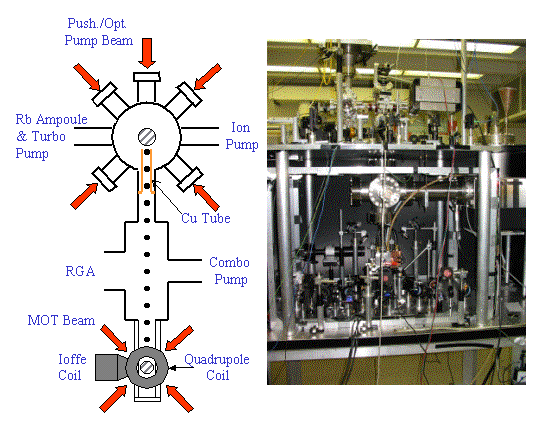
Apparatus: Above is a photograph showing the upper and lower vacuum chambers. Atoms are first cooled in the upper vapour cell magneto-optical trap. A laser then pushes the atoms into the lower chamber which is at a pressure of about 2 x 10-11 torr. The atoms are then trapped in a second magneto-optical trap and subsequently loaded into a so called QUIC trap. Evaporative cooling is finally used to achieve Bose Einstein Condensation
(Click here for Fun with Ultracold Atoms Talk) Bose Einstein Condensation (BEC) was first proposed by S. Bose and A. Einstein in 1924 who predicted that near absolute zero, bosons (particles with integral spin) would all occupy the same state. This prediction did not immediately attract experimental interest because no one had any idea how to achieve such ultralow temperatures. It was not until the mid 1990s after novel methods to cool atoms using lasers and store them in magnetic traps had been developed, that BEC was first observed.
Our group was the first in Canada to achieve BEC. Rb atoms were first laser cooled in a magneto-optical trap (MOT). The atoms were subsequently loaded into a magnetic or optical trap where they were evaporatively cooled to create a BEC consisting of about half a million atoms. The predicted temperature dependence of the condensate fraction was verified to temperatures as low as 7 nanoKelvin. The temporal evolution of the condensate shape was used to determine the s-wave scattering length in excellent agreement with photoassociative spectroscopy. The Rb D2 natural linewidth was measured yielding the 5P3/2 lifetime to an accuracy of 0.3%, one of the most accurate lifetimes ever determined.
Recently, we developed a linear array of microtraps each consisting of a pair of concentric microwire loops having radii 300 and 660 microns, carrying oppositely oriented currents. Atoms were successfully loaded into the microtraps from either a FORT or a MOT. The atom position above the chip could be precisely adjusted using an external magnetic field from 300 to below 50 microns. The eventual objective is to implement our design for a two dimensional microtrap array of neutral atoms. It is of interest for exploring and controlling the interactions between ultracold atoms such as the transition between a superfluid and a Mott insulator state and developing schemes to implement quantum computing.
A number of exciting applications can be done using BECs. For example, BEC has enabled so called atom interference experiments to where the atoms behave like two interfering water waves. An experiment was also done to stop light with a BEC. It will be interesting to explore whether the extremely low temperatures can be exploited to generate extremely tightly collimated beam. The latter would be of great interest for nanolithography, a newly created field that seeks to create circuits/devices having dimensions of nanometers. The long range goal would be to use smaller faster semiconductor chips to create faster computers.